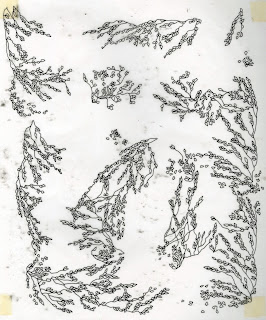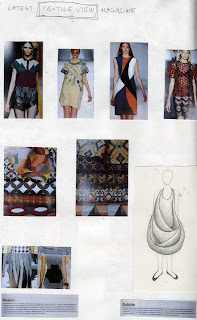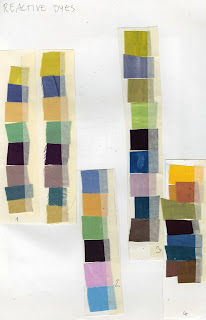In
third year we had the opportunity to participate in different design
competitions that helped us to step out of our comfort zone and develop new
skills. For the RSA competition I
designed fabrics for the interiors of a community space that was going to bring
different generations together to learn from each other and spend more time
together. Colour was the main focus of
my research. I went to the town centre
to ask people about what they would like to have in a community space like this
if it would exist and what colours would they prefer to see in the interiors. I have read different books about colour
theories and how different shades affect different age groups and people in
general. Colour remained a very
important part of my projects since it helps me to describe different moods and
provoke different emotions.
For
the SDC competition we were asked to choose a trend forecast as an inspiration.
My choice was called ‘21st
century avant-garde – a new rebellious renaissance, super hybrid art movements
communicate a diverse message…with a punch of colour’. I used my own photographs of the urban
environment to create an interesting colour palette. I also looked at different art movements and
combined them into an eclectic design. The
message I was trying to communicate was based on my belief that we have to stop
being selfish and ruining our environment. Symbols and colour helped me to generate a
special mood and tell a story. I started
to use Photoshop to combine drawings from my sketchbook and find the perfect
compositions for my final designs. Photoshop became my main design tool for the
Bradford competition since I really enjoyed
the possibilities of trying out different things quickly and playing with
colour. I became confident about
designing on a computer and even though I respect traditional techniques much
more it is a great way to do quick experiments.
For
my dissertation I carried out research on the harmful nature of the fashion
industry. Fast fashion puts a major
pressure on people who produce the items and causes a lot of damage in the
environment. I was looking at different
organisations and designers who try to fight against these issues. I interviewed a social enterprise called Fox
and BHut that sell ethical fashion items out of their caravan in St Andrews at eco-festivals and also visit universities
to spread a message about sustainability. Taking inspiration from this, in the future I
would like to inform customers about my techniques and materials I use for my
one-off fashion pieces and encourage them to buy unique hand made items that
can be treasured for a long time instead of mass produced disposable ones. In my dissertation I have considered setting
up my own business to sell my products at eco-friendly festivals, as their
audience seems to be a perfect niche market for my quirky designs. Prior to this, I would like to further my
experience by learning new skills and techniques in the professional textile
industry.
CONTEXT:
During
my research into sustainability I found out that upcycling is one of the most environmentally friendly ways of
production, as it reduces textile waste and saves the water and energy used for
the manufacture of raw materials.
It is also cost effective,
as I discovered during my research there is a real need for quality,
affordable, sustainable clothing. I
gather my source materials from charity shops and discarded second-hand items
to give them a second life and turn them into one-off fashion garments. There are several companies dealing in
upcycled fashion by reconstructing existing pieces or putting existing
patterned fabrics together. However,
very few produce reprinted garments and those that do produce mostly T-shirts. In reported articles, the majority of
consumers believe the only eco-friendly clothing currently available is organic
cotton T-shirts and clothing which they found to be unfitted, rough to the
touch, restricted in different styles and colours, and often described as ‘made
for hippies’. I am looking for soft,
natural, plain materials to print my designs onto and re-construct them into
one-off fashion pieces. This allows me
the opportunity to use unwanted domestic fabrics as well as clothing.
AREA OF RESEARCH:
In the past few years I have
used my photography of nature and the urban landscape as an inspiration. It gave me the idea to use the contrast
between natural and man-made environments to communicate a message. First world modern society has had a major
impact on planet Earth. As time passes,
our ‘disconnection’ with nature is increasingly changing our everyday life. With my final designs I intend to raise
globalization awareness and our responsibilities towards the planet. I would like to capture the hidden nature of
flora in the urban landscape and encourage people to realise the beauty and
energy of plants.
My aim is to use
techniques that have as little impact on the environment as possible.
In semester one I used
Photoshop to put together my drawings of buildings, scaffoldings and plants. I was going to use digital prints because it
does not come with any waste therefore safe for the ecosystem. However, I realised that one of my strengths
is free-hand drawing and therefore I have much more possibilities in
traditional printing to create quirky designs instead of the sterile outcome of
digital prints. I experimented with
non-toxic dyes but unfortunately their quality was not good enough for the
fashion market. I contacted the company
that supplies the dyes we are using at the university to find out more about
how harmful they actually are. As it
turned out they certified to use on organic fabrics so I can use them safely with
a clear conscience for my project. I have
experimented with more harmful techniques like devore and discharging in the
past and found them very useful to create unique textures and surfaces but in
this project I stayed away from them.
The biggest challenge for
me was to put together all the information I gathered in my sketchbooks without
overcomplicating and overdoing my samples. Therefore the most important skill I have
learnt during this project is how to keep my designs simple but still have a
quirky uniqueness about them.
As a final result I made
bigger hand printed samples and shaped them into dress fronts to demonstrate
their fashion context. It also allowed me to use them for photo shoots to
represent my target audience.

















































